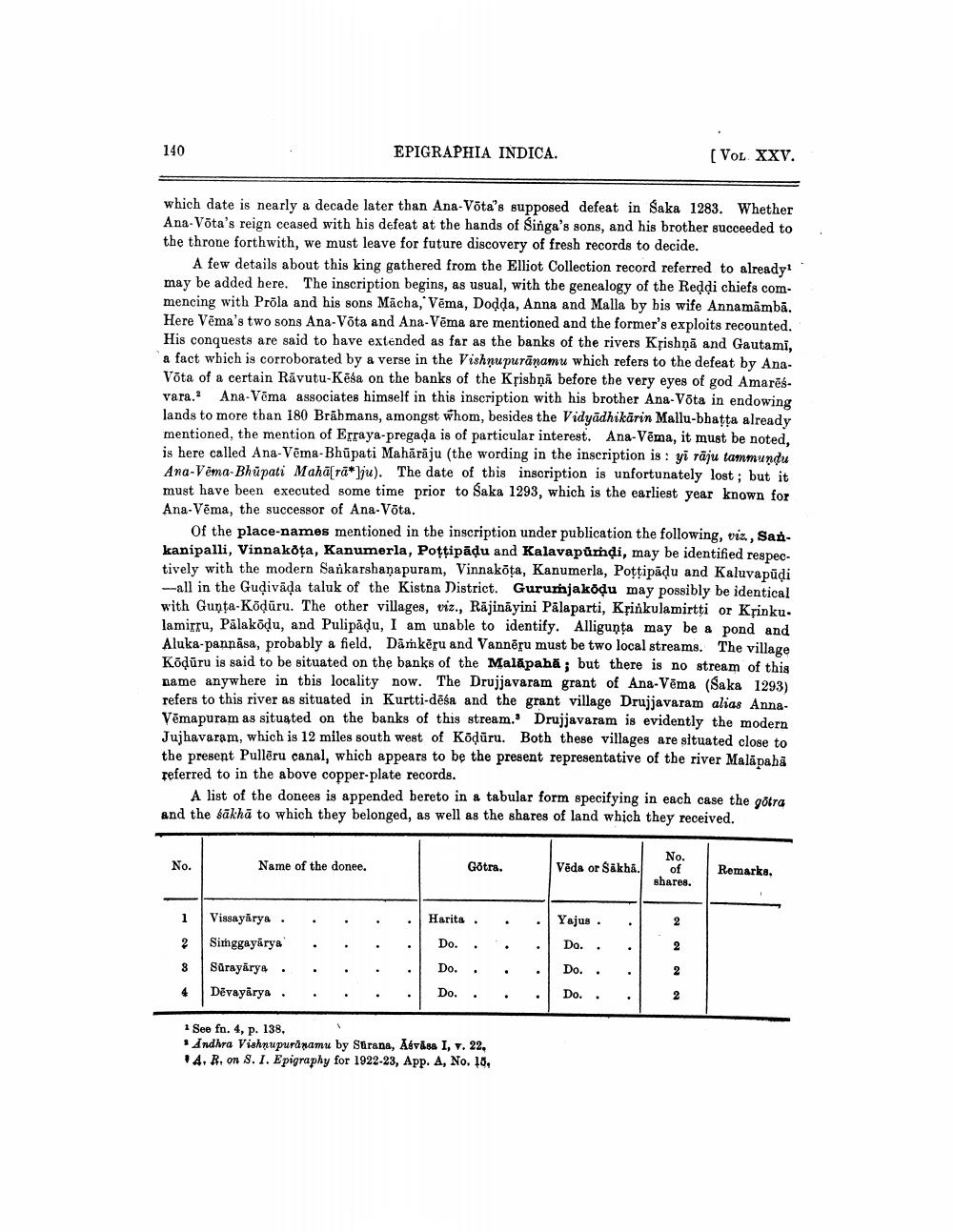________________
140
which date is nearly a decade later than Ana-Võta's supposed defeat in Saka 1283. Whether Ana-Võta's reign ceased with his defeat at the hands of Singa's sons, and his brother succeeded to the throne forthwith, we must leave for future discovery of fresh records to decide.
A few details about this king gathered from the Elliot Collection record referred to already1 may be added here. The inscription begins, as usual, with the genealogy of the Reddi chiefs commencing with Prōla and his sons Macha, Vēma, Dodda, Anna and Malla by his wife Annamamba. Here Vema's two sons Ana-Võta and Ana-Vēma are mentioned and the former's exploits recounted. His conquests are said to have extended as far as the banks of the rivers Krishna and Gautami, a fact which is corroborated by a verse in the Vishnupuranamu which refers to the defeat by AnaVõta of a certain Rävutu-Keša on the banks of the Krishna before the very eyes of god Amaresvara. Ana-Vēma associates himself in this inscription with his brother Ana-Võta in endowing lands to more than 180 Brahmans, amongst whom, besides the Vidyadhikarin Mallu-bhatta already mentioned, the mention of Erraya-pregada is of particular interest. Ana-Vēma, it must be noted, is here called Ana-Vēma-Bhupati Mahārāju (the wording in the inscription is: yī rāju tammundu Ana-Vema-Bhupati Maharaju). The date of this inscription is unfortunately lost; but it must have been executed some time prior to Saka 1293, which is the earliest year known for Ana-Vēma, the successor of Ana-Võta.
EPIGRAPHIA INDICA.
Of the place-names mentioned in the inscription under publication the following, viz., Sankanipalli, Vinnakota, Kanumerla, Poṭṭipāḍu and Kalavapurdi, may be identified respectively with the modern Sankarshanapuram, Vinnakōṭa, Kanumerla, Poṭṭipaḍu and Kaluvapūḍi -all in the Gudivada taluk of the Kistna District. Gurumjaköḍu may possibly be identical with Gupta-Kōḍūru. The other villages, viz., Rājināyini Palaparti, Krinkulamirtți or Krinku. lamirru, Palakōḍu, and Pulipadu, I am unable to identify. Alligunta may be a pond and Aluka-pannāsa, probably a field. Damkēru and Vannēru must be two local streams. The village Kōdūru is said to be situated on the banks of the Malapaha; but there is no stream of this name anywhere in this locality now. The Drujjavaram grant of Ana-Vēma (Saka 1293) refers to this river as situated in Kurtti-deśa and the grant village Drujjavaram alias AnnaVēmapuram as situated on the banks of this stream. Drujjavaram is evidently the modern Jujhavaram, which is 12 miles south west of Köḍūru. Both these villages are situated close to the present Pullēru canal, which appears to be the present representative of the river Malapaha referred to in the above copper-plate records.
No.
A list of the donees is appended bereto in a tabular form specifying in each case the götra and the sākha to which they belonged, as well as the shares of land which they received.
Name of the donee.
1 Vissayārya
2 Simggayārya
3 Sürayārya
4
Devayarya
.
Harita
Do.
Do.
Do.
Götra.
•
•
1 See fn. 4, p. 138.
Andhra Vishnupuranamu by Sarana, Aévása I, v. 22,
4. R. on S. I. Epigraphy for 1922-23, App. A, No. 18,
.
Vēda or Säkha.
Yajus.
Do.
Do.
Do.
•
[VOL. XXV.
No. of shares.
2
2
2
2
Remarks.




